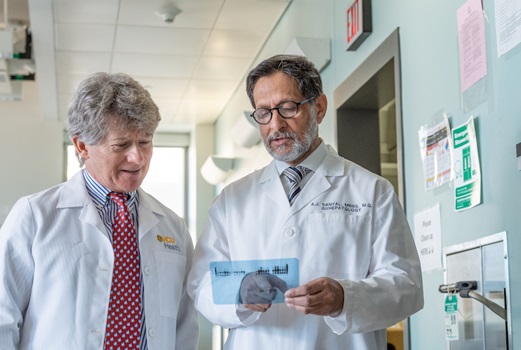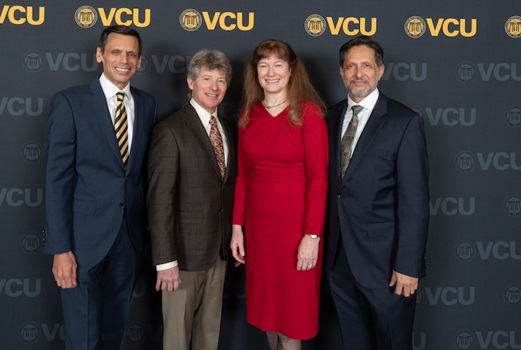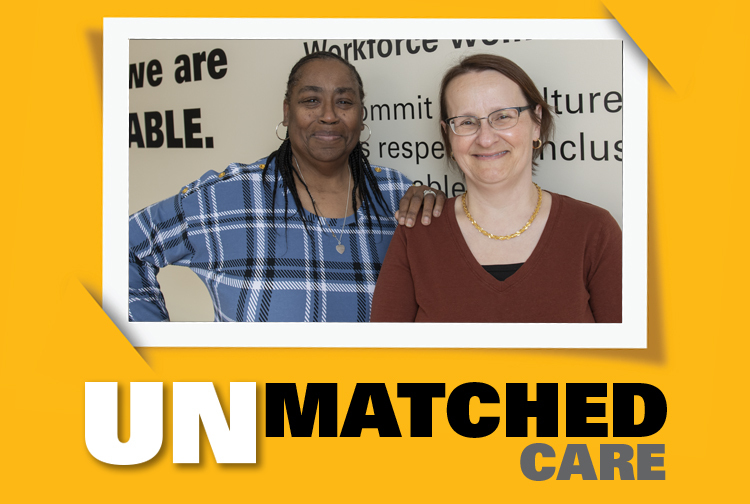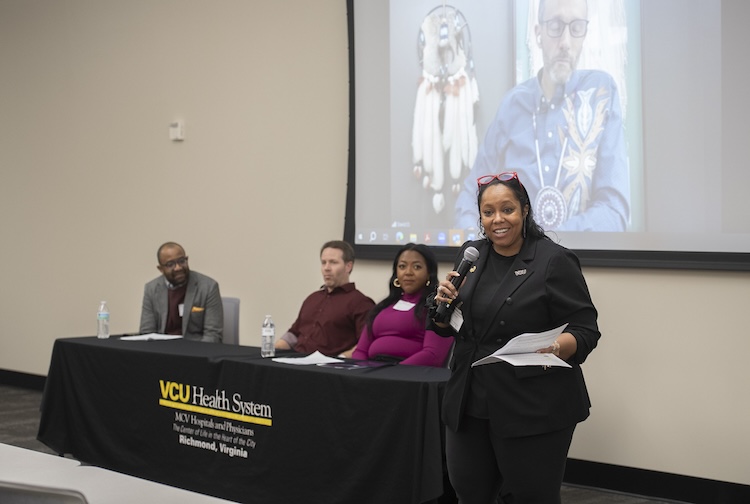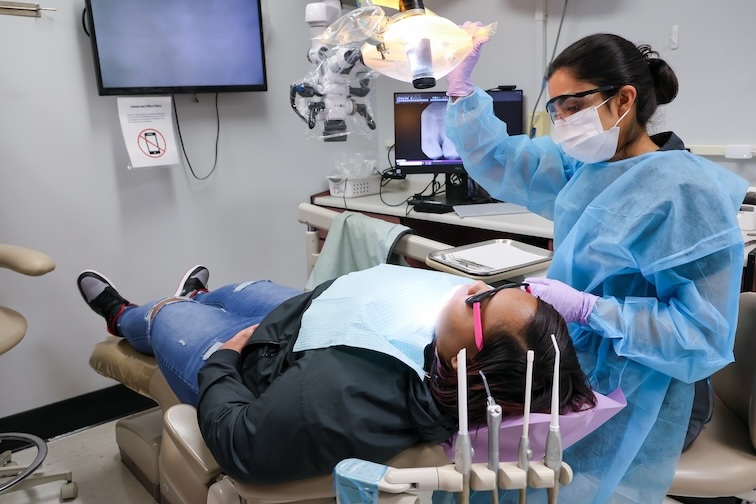
Gaining momentum for liver care: Arun Sanyal reflects on the VCU liver institute’s first year
One year has passed since the establishment of the Stravitz-Sanyal Institute for Liver Disease and Metabolic Health at VCU. Sanyal discusses the institute’s biggest strides in its first year and next steps on the path to advancing liver health.
February 15, 2023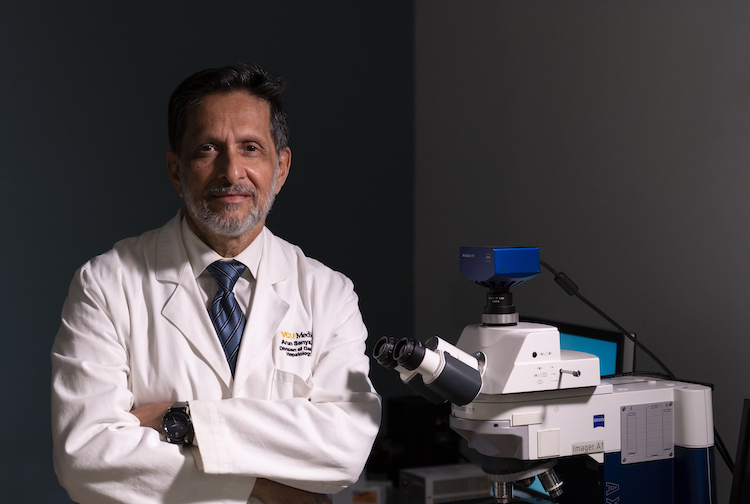 Arun Sanyal, M.D., director of the Stravitz-Sanyal Institute for Liver Disease and Metabolic Health, shares insights into the institute’s achievements over the past year and how it is shaping the future of liver care. (VCU Enterprise Marketing and Communications)
Arun Sanyal, M.D., director of the Stravitz-Sanyal Institute for Liver Disease and Metabolic Health, shares insights into the institute’s achievements over the past year and how it is shaping the future of liver care. (VCU Enterprise Marketing and Communications)
By Olivia Trani
In December 2021, Virginia Commonwealth University shared its plan to create an institute for liver disease and metabolic health, building on the university’s legacy of championing liver health through translational research, education and clinical care. Just two months following the announcement, in February 2022, the institute received a historic $104 million gift, the largest publicly shared donation for liver research in U.S. history, from R. Todd Stravitz, M.D., and his family’s Barbara Brunckhorst Foundation.
Backed by this gift, the Stravitz-Sanyal Institute for Liver Disease and Metabolic Health is dedicated to radically transforming the lives of patients by accelerating the pace of innovation for preventing, diagnosing and treating liver disease.
More than one year since its establishment, the institute has made great strides in its mission, including:
- Expanding the institute’s team of dedicated liver and metabolic health experts.
- Strengthening existing partnerships and forging new collaborations with research centers and organizations that share VCU’s goal in relieving the burden of liver disease.
- Convening researchers last fall for its inaugural academic symposium to celebrate the latest advances in liver care and share new insights into liver disease and related illnesses.
“This institute and this gift are really about transforming the lives of not just individual patients, but entire populations across the world,” said Patricia Sime, M.D., chair of the Department of Internal Medicine at the School of Medicine. “It’s wonderful to think of the impact that this institute has had in just one year, and I’m excited to see how we will further build on the foundation of VCU’s hepatology program and catapult to success.”
“We are helping create a global community to shift the paradigm for liver health, so that our patients, both in Virginia and beyond, can get the care they need faster. I’m incredibly proud of what we have accomplished, and we’re only just getting started,” said Arun J. Sanyal, M.D., director of the Stravitz-Sanyal Institute for Liver Disease and Metabolic Health.
Sanyal shared insights into the institute’s achievements over the past year and how it is shaping the future of liver care.
R. Todd Stravitz, M.D., and Arun Sanyal, M.D. (VCU Enterprise Marketing and Communications)
What have been some of the biggest accomplishments for the institute in its first year?
In terms of research, we have been establishing multiple strategic partnerships with members of the industry sector to create new diagnostic technologies and therapies for liver disease and metabolic health.
For example, one of the biggest challenges with liver disease is scar tissue from chronic inflammation, which progressively replaces healthy liver cells over time. Many of our collaborations are targeted around improving tools for assessing and treating this kind of scarring. At this point we’re right at the cutting edge of science, but the implications could be transformational for patients suffering from liver disease.
Additionally, our collaborations with academic centers and health organizations from around the world have really taken off, formalizing our global footprint as a leading institute for liver research.
This includes collaborative efforts with universities in Brazil, Turkey, Singapore and India, to name a few.
One project that comes to mind is our recent work with health agencies and institutions in Mexico to help establish mechanisms to identify and track the burden of liver disease in the country, as well as develop efficient treatment pathways for patients in need of liver care. This will have an immediate impact for the millions of people in Mexico affected by poor metabolic health. Very few of us are fortunate enough to be a part of something that can touch a million lives, let alone 50 million lives, or even carry the potential of affecting a billion lives around the world.
Around this time last year, the institute received a historic $104 million gift from R. Todd Stravitz, M.D., and the Barbara Brunckhorst Foundation. In what ways has the gift supported the institute in its first year?
The most important thing that the gift has done for us this year is getting more momentum behind the creation of the institute.
This has been especially important for growing our research workforce and establishing our leadership team. Having bright, passionate and creative people on our team is critical for the institute’s infrastructure and operations.
Could you talk more about the vision for this expanding team and how you see their expertise advancing research and care for liver disease and metabolic health?
In this regard, we have a three-pronged approach.
First is to continue to recruit faculty working on metabolic health and how it connects to liver injury, inflammation and scarring. If you look at the leading causes of death, many of them are linked to your metabolism going in overdrive, which leads to accelerated aging in multiple organs.
The second goal is to establish collaborative partnerships with researchers from different specialties who study diseases that share common biology. Liver disease is at the foundation of many other metabolic problems. By working together, we can share ideas, find new discoveries and develop therapies relevant to a wide array of health issues.
And third is to expand our expertise in areas where knowledge gaps exist, such as rare diseases. By creating additional expertise and focus on rare diseases, we aim to become a destination for care for patients living with these conditions. We’re very pleased to say that we now have clinics for illnesses like sarcoidosis, a disease in which small clusters of inflammatory cells take form in different organs in the body, and cholestatic liver disease, in which the bile produced in your liver is slowed or stalled. These are things that we were able to achieve as a result of creating this institute.
VCU President Michael Rao, Ph.D.; R. Todd Stravitz, M.D.; Patricia Sime, M.D.; and Arun Sanyal, M.D. (VCU Enterprise Marketing and Communications)
What's next for the institute?
We are looking forward to eventually making infrastructure changes that would allow us to increase our capacity for patient care, develop new capabilities and technologies for patient-oriented research, and promote educational activities for the next generation of liver health experts.
What do you envision for the future of liver care and the institute?
Liver disease is called a “silent killer” because the liver won’t tell you when things start to go wrong. It will quietly keep trying to work away until one day it just gives up. By the time symptoms for liver disease become apparent, a liver transplant is often the only treatment option. Liver transplantation is a life-saving treatment, but many patients with advanced liver disease will never have access to one in their lifetime due to overwhelming demand.
My hope is that we move upstream of this issue through easier diagnostics, more accessible therapeutics and health care policies that promote disease prevention. The day we know we’ve prevented anybody from needing a transplant is the day that we have succeeded.

